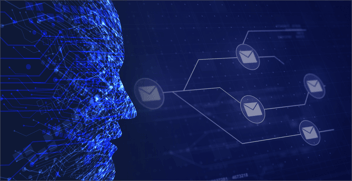Conversational AI vs Chatbot - A Detailed Analysis

- Consumer-business Communication
- Lead Generation
- Customer Support
- Marketing
More often than not, the two terms are used interchangeably, a trend that has left the marketing and business communities confused. While both of these tools are used in similar business procedures, the extent to which they optimize and augment the processes varies greatly. When thinking of integrating either of the two technologies, businesses must develop a comprehensive understanding of the fundamental differences between conversational AI and chatbots.
Defining the difference
Let’s take a look at the features that differentiate the two:
Algorithm
Chatbots run on rule-based algorithms that use conditional statements to dictate the flow of conversations. Basically, the scope of chatbots interactions’ with users is restricted to the number of keywords it can identify and has been trained for. On the other hand, conversational AI leverages deep neural learning network algorithms along with natural language processing and understanding capabilities to comprehend and humanize conversations with users. The sophisticated tool assesses user responses in real-time to empathetically interact with customers and mimic the flow of a natural conversation.
Context Awareness
Leveraging its sophisticated algorithm coupled with natural language processing and understanding capabilities, conversational AI comprehends the semantics of a conversation to understand the context. Unlike chatbots, conversational AI is not restricted to a fixed set of keywords and can respond to queries when phrased in different ways. Contrastingly, chatbots fail to understand context switches and are not designed to respond to anything out of the scope of statements hard-coded in their programs. Consequently, customers interacting with chatbots are likely to end up frustrated if they use words and phrases beyond the scope of keywords for which the tool is trained.
Self-learning Capabilities
Although both of the technologies are labeled as artificial intelligence, it is important to note that only conversational AI is equipped with self-learning capability. Once deployed, conversational AI learns from every interaction and refactors its algorithm to seamlessly incorporate the learnings. This is not the case with chatbots. Chatbots need to be explicitly and manually trained for every phrase and keyword.
Scalability
Chatbots are designed for execution of specific use cases based around a predetermined flow of conversation. This aspect of the tool makes it impossible for scaling its use to other aspects of businesses. Conversational AI, on the other hand, learns on the go and can be easily scaled to optimize a variety of operations.
Optimization
Fine-tuning and optimizing the performances of these tools is key to ensuring they deliver significant return on investment (ROI). In the case of chatbots, optimization translates to the manual changing of rules /scripts and addition of new flows to conversations, a process that is time-consuming and requires significant investments. On the other hand, optimizing conversational AI only involves bootstrap training using historical data, a process that requires substantially less time and efforts.
Final Verdict
Conversational AI is designed to help businesses engage in meaningful, one-on-one personalized conversations with customers. With the demand for personalization and humanization of B2C interactions, conversational AI platforms are helping companies scale their marketing campaigns affordably. Moreover, the intelligent virtual assistants are enriching consumer journeys to help brands increase customer acquisition rates while substantially reducing attribution.
Conversational AI – Driving Disruption Across Sectors
The numerous benefits and use cases of conversational AI are driving industries to the new era of automation and optimization. A recent survey by Accenture revealed that over 56% of CIOs and CTOs believe that conversational AI is driving disruption in their industries while 57% agree that technology has the potential to deliver large ROI. By using Meera conversational AI a renowned university boost its ROI by 625%. The sophisticated virtual assistant is tailored to handle an array of responsibilities such as customer support, lead generation, prospecting, meeting scheduling, and collection of RSVP confirmations. Initially, the integration of conversational AI into the business structure might seem like an arduous task, however, with proper planning and strategizing the intelligent assistant can help you scale your business to new heights.

About Meera
Meera is an A.I.-driven text messaging & communication automation platform that emulates human conversations at scale through preferred channels. The platform also streamlines connectivity with customers to enhance sales, marketing, and service processes


.png?width=512&height=512&name=guru%20(1).png)

.png?width=199&height=109&name=salesforce-logo1-removebg-preview%20(1).png)




